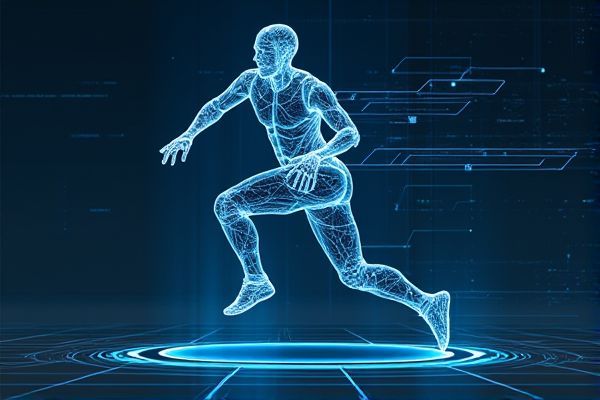
AI is revolutionizing sports science research by enabling precise analysis of athlete performance through data collection from wearables and sensors. Machine learning models can process vast amounts of data, identifying patterns that inform training regimens, injury prevention strategies, and recovery protocols. Personalized insights are generated, helping coaches tailor programs to individual athletes, thereby enhancing overall performance. Furthermore, predictive analytics offers the potential to forecast injury risks, allowing teams to implement proactive measures to safeguard their players' health.
AI usage in sports science research
Performance Analytics
AI implementation in sports science research offers the potential for enhanced performance analytics through data-driven insights. For instance, using machine learning algorithms can help in identifying patterns that predict athlete performance improvements. This technology enables coaches and sports scientists to optimize training regimens tailored to individual athletes, potentially leading to better outcomes in competitions. Institutions like the University of Georgia are increasingly exploring these advancements to gain a competitive edge in sports performance.
Injury Prediction
AI has the potential to enhance injury prediction in sports science research by analyzing vast amounts of data from athletes' performance metrics and medical histories. Machine learning models can identify patterns that human analysts might miss, thus improving the chances of early injury detection. For instance, data from institutions like the American College of Sports Medicine can provide valuable insights into athlete health and conditioning. Implementing AI in this manner could lead to significant advancements in preventative strategies for injuries in various sports.
Biomechanical Analysis
AI offers the potential to enhance biomechanical analysis in sports science research by providing precise data interpretation. For example, it can analyze an athlete's movement patterns through video footage, allowing for better injury prevention strategies. This technology may also facilitate personalized training programs, leading to improved performance. The integration of AI can thus create opportunities for more effective and tailored sports training methodologies.
Sports Strategy Optimization
AI can significantly enhance sports science research by analyzing vast amounts of performance data, leading to improved training methods. Techniques such as machine learning can help identify patterns that inform player fitness and injury prevention strategies. For instance, analyzing player movements using AI can optimize game strategies in sports like soccer. The potential for real-time data processing allows teams to make informed decisions that could give them a competitive edge.
Personalized Training Programs
AI can enhance sports science research by analyzing athlete performance data to develop personalized training programs. For instance, institutions like the Georgia Institute of Technology use machine learning algorithms to tailor training sessions to individual athlete needs. These programs may lead to improved performance by optimizing workout intensity and recovery strategies. The possibility exists for AI to contribute significantly to individualized coaching methods in various sports.
Real-Time Data Tracking
AI usage in sports science research enhances real-time data tracking, allowing for immediate analysis of athlete performance. For example, institutions like the National Institute of Sports Science have adopted such technologies to monitor player metrics during training sessions. This capability opens up the possibility of optimizing training regimens based on live feedback. Coaches can make informed decisions quickly, potentially improving athlete outcomes and performance efficiency.
Talent Identification
AI is increasingly being utilized in sports science research for talent identification, optimizing the selection process for athletes. By analyzing large datasets, AI can uncover patterns that human evaluators might miss, leading to more accurate predictions of an athlete's potential. For example, institutions like the Australian Institute of Sport employ machine learning models to assess performance metrics and biometric data. This use of AI not only enhances the efficiency of talent scouting but may also improve overall athlete development outcomes.
Rehabilitation Management
AI has the potential to enhance sports science research by providing deeper analysis of athlete performance data. In rehabilitation management, AI can offer personalized recovery plans based on real-time monitoring of injuries. For example, a system like Smart Rehab could analyze movement patterns to suggest targeted exercises. The integration of AI in these areas may lead to improved outcomes for athletes and a more efficient recovery process.
Nutritional Optimization
AI can significantly enhance nutritional optimization in sports science research by analyzing athletes' dietary habits and performance data. For instance, institutions like the National Institute of Sports Science can leverage machine learning algorithms to predict optimal nutrient intake. This predictive capability allows for tailored nutrition plans that may improve recovery and enhance performance. The application of AI in this area holds the potential to provide athletes with a competitive advantage in their respective sports.
Game Simulation and Modeling
AI in sports science research enhances the analysis of player performance through data-driven insights. Game simulation and modeling can predict outcomes and improve strategic decision-making for teams like Manchester City. This technology allows for the exploration of various game scenarios without the risks of real gameplay. The potential to optimize training methods through AI analytics can provide a competitive edge to athletes and coaches alike.
 techknowy.com
techknowy.com